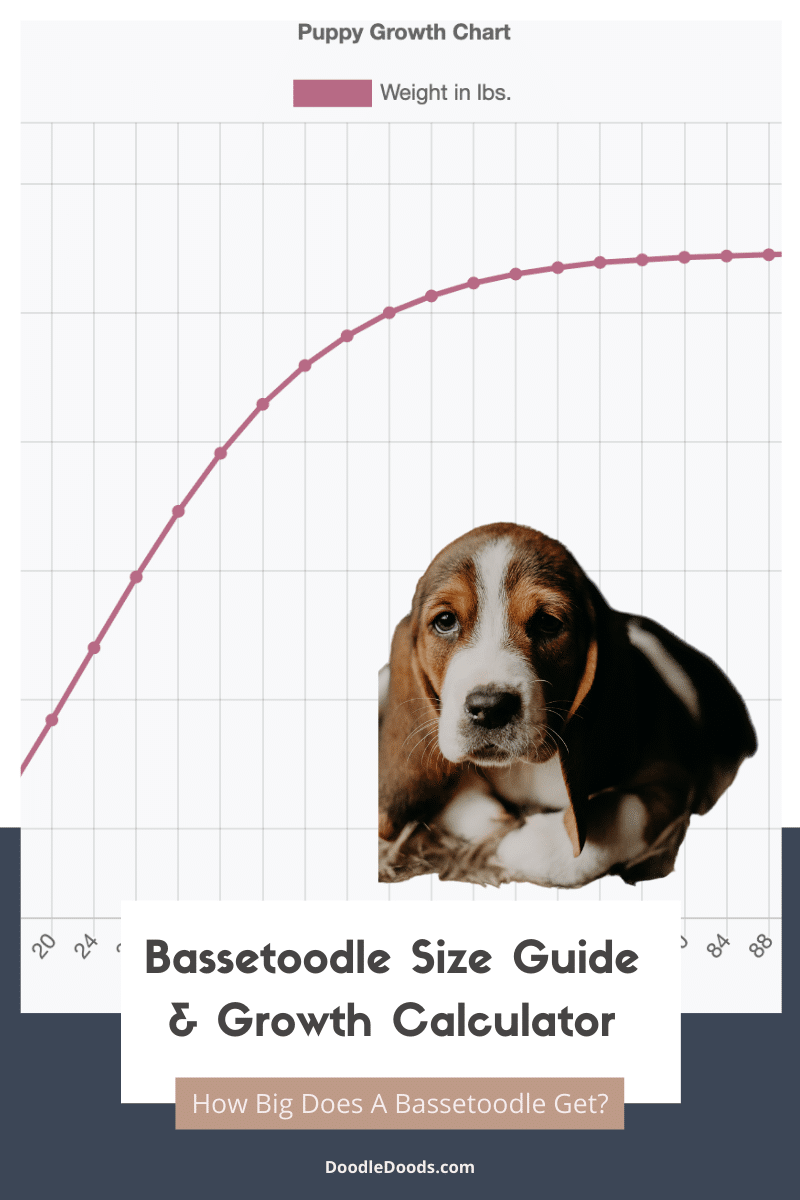The Bassetoodle might not be as popular as some other Poodle mixes, but they’re definitely becoming more and more known thanks to their many amazing qualities. In this guide, we’re going to take a closer look into the Bassetoodle size and growth patterns, and discuss what are the main factors that can affect a Bassetoodle’s size. Let’s get into it!
Table of Contents
- Bassetoodle Size: Intro
- Bassetoodle Size Predictions: How Big Does A Bassetoodle Get?
- Are There Different Sizes Of Bassetoodle?
- Bassetoodle Size Charts & Growth Patterns
- Bassetoodle Size: FAQ
- Bassetoodle Size: Final Thought
Bassetoodle Size: Intro
If you’re one of those lucky few who get to raise a not-so-purebred Bassetoodle, then you’d likely want to learn all about their size and growth patterns. After all, how can you be prepared for many years to come with your precious Dood if you don’t even know how big they’ll get, right?!
Like other Doodles, the Basset Hound-Poodle mix is known by multiple names – the Bassetoodle, Bastoodle, Basset Poo, and Bassetdoodle, to name a few. Even though their purebred Basset Hound and Poodle parents are one of the most recognizable dog breeds out there, the Bassetoodle is one of the newer hybrid crosses that not many breeders specialize in. Nonetheless, we expect Bassetoodles to blow up just like any other Poodle mix – they’re simply that amazing!
Like their purebred parents, Bassetoodles are loving and friendly pups with high levels of intelligence and allergy-friendly coats. But what about their size? As you probably know, Basset Hounds and Poodles are two very different dogs with very different builds, which makes the guesswork a bit more complicated…
Bassetoodle Size Predictions: How Big Does A Bassetoodle Get?
Bassetoodles generally weigh between 20 and 30 pounds with an average height of around 12 to 16 inches at the shoulder. Like their purebred Basset Hound parents, Bassetoodles often have a stocky and muscular build with short legs and long bodies. How cute is that!
| Bassetoodle | |
| Weight | 20-30 pounds |
| Height | 12-16 inches |
| When Full-Grown? | 11-13 months |
Most commonly, the Bassetoodle mix uses a Miniature Poodle. Purebred Basset Hounds might be tiny with their height of less than 14 inches, but they’re actually quite heavy pups with their weight ranging between 40 and 65 pounds.
On the other hand, Miniature Poodles only weigh around 10 to 20 pounds with a height between 10 and 15 inches at the shoulder. But let’s not forget, there’s also the Standard Poodle whose weight is actually much closer to the Basset Hound’s – Standard Poodles can weigh anywhere from 38 to 70 pounds, give or take. However, with their average height of 24 to 27 inches, their height makes them slightly too big to cross them with Basset Hounds.
Likewise, the smallest Toy Poodle with a weight between 4 and 15 pounds is a bit too tiny to cross with a Basset Hound. However, as the Bassetoodle mix becomes more popular in the future, we can expect breeders to add more Toy variations into the mix as well.
Are There Different Sizes Of Bassetoodle?
So, as we learned, breeders can actually use either Standard, Miniature, or Toy Poodles to create Bassetoodle puppies. However, as of now, the most popular choice amongst breeders (and also Doodle lovers) is to cross a Basset Hound with a Miniature Poodle, as their size is the most compatible in that sense. But, let’s take a closer look at the different possible Bassetoodle sizes.
Mini & Standard Bassetoodle
As we know, Bassetoodles are usually created by using a Miniature Poodle in the mix. This will result in a pup that will weigh between 20 and 30 pounds once fully grown.
However, if you do come across a rare sighting of a Bassetoodle with a Standard Poodle parent, these pups will likely weigh in the range of about 40 and 70 pounds, just like their purebred Basset Hound and Poodle parents. Of course, these pups will likely be significantly taller as well, which means that their Basset Hound heritage may not be as noticeable anymore.
Similarly, if a Toy Poodle is used in the mix to achieve smaller Bassetoodles, these pups can weigh significantly less, even around 10 pounds on average.
How Generation Can Affect Bassetoodle Size
Another interesting factor to take into account when predicting the Bassetoodle’s size is their generation. If you know a little bit about hybrid breeds and Poodle mixes, you know that they’re categorized into generations. It’s a confusing topic, we know! To put it simply, a Bassetoodle’s generation will tell us how their litter was bred, and also help us gain a better understanding of their potential traits in terms of looks, coat type, size, and even personality. Here’s what we mean exactly:
| 1st Parent | 2nd Parent | % Basset Hound* | % Poodle* | |
| F1 Bassetoodle (first-generation) | Basset Hound | Poodle | 50% | 50% |
| F1B Bassetoodle (first-generation backcross) | F1 Bassetoodle | Poodle | 25% | 75% |
| F1BB Bassetoodle (first-generation backcross backcross) | F1B Bassetoodle | Poodle | 12.5% | 87.5% |
| F2 Bassetoodle (second-generation) | F1 Bassetoodle | F1 Bassetoodle | 50% | 50% |
| F2B Bassetoodle (second-generation backcross) | F1 Bassetoodle | F1B Bassetoodle | 37.5% | 62.5% |
| F2B Bassetoodle (alternate cross) | F2 Bassetoodle | Poodle | 25% | 75% |
| F3 / Multigen Bassetoodle | F1B Bassetoodle or higher | F1B Bassetoodle or higher | Varies | Varies |

So, as we can learn from this chart, each generation helps breeders achieve more control over the outcome. For instance, with F1 Bassetoodles the outcome may lean on either side of their lineage, as their genetic makeup is a rough 50-50 mix of both the Poodle and the Basset Hound. Meanwhile, if a breeder’s goal is to achieve smaller and not so heavy Bassetoodles with more Poodle-like coats, they can cross a Bassetoodle back to a Miniature Poodle.
As the Bassetoodle is such a new Poodle mix, they’re most commonly bred as either F1 or F1b pups. But in the near future, we can expect to see more variations of this beautiful crossbreed. For example, if in the future Toy Poodles are introduced into the mix, these pups will likely be F1b, F2, or later Bassetoodles to even out the size difference.
Gender Differences
As the Bassetoodle is quite a small dog, there usually isn’t a big difference between male and female Bassetoodles. Still, sometimes male pups may be slightly, just slightly heavier and taller than their female counterparts.
Bassetoodle Size Charts & Growth Patterns
Like any other breed or crossbreed, Bassetoodles generally grow the fastest in the first 50% of their adult weight. On average, this usually correlates to the first six months of their life. However, as the Bassetoodle size is quite small, we can expect them to grow much faster and reach their full adult size much sooner than some larger breeds and hybrid crosses.
The process usually goes like this – a Bassetoodle will grow the fastest up until they reach half their adult weight, after which their growth will start to gradually slow down. They generally reach their full adult height a couple of months before reaching their full adult weight, as it will take a bit time for them to fill out and gain some more girth.
Tip for predicting your Bassetoodle’s size: Make sure you give our interactive Doodle Weight Calculator a try, as this helpful tool will help predict your Bassetoodle’s full-grown size and track their growth from puppyhood into their adult years. Simply enter your Doodle’s type, estimated adult size, current weight in pounds, and current age in weeks, and our calculator will take care of the rest!
As Bassetoodles generally weigh between 20 and 30 pounds once fully grown, they’re categorized as mini/medium sized dogs. Based on the estimates, they tend to reach half their adult weight around the time they’re 3.5 to 5 months old, after which their growth will start to slow down. We can usually expect a Bassetoodle to plateau at their full adult weight between 11 and 13 months of age. As a general rule of thumb, smaller Bassetoodles tend to finish growing sooner than larger Bassetoodles – something worth remembering!
You can also use this simple formula to predict your Bassetoodle’s size as an adult:
Bassetoodle Size: FAQ
Bassetoodles usually weigh between 20 and 30 pounds with an average height of around 12 to 16 inches at the shoulder. Of course, a Bassetoodles size depends on a variety of factors, including the size of their parents, their unique genetic makeup, but also their generation.
Most commonly, Bassetoodles are created by using a Miniature Poodle in the mix. Therefore, the usual Bassetoodle is sometimes referred to as the Mini Bassetoodle due to their Miniature Poodle heritage.
Bassetoodle Size: Final Thought
Even though the Bassetoodle might not be as popular as the OG Goldendoodle or Labradoodle, they’re every bit as adorable and amazing as any other Doodle out there. They combine the best traits from the purebred Basset Hound and Poodle, resulting in the most loving, sweet-natured, and social pups. And let’s not forget, their Poodle heritage will only give them the advantage of shedding much less than the purebred Basset Hound. So, if you’re already head over heels in love with the Bassetoodle and can’t wait to bring one home, knowing what to expect in terms of their size and growth is vital. Our Bassetoodle size calculator will surely help you keep track of your pup’s growth so you can ensure that your pup is getting the best start in life.
Learn How to Care for Your Doodle Puppy!

Perfect for first-time Doodle parents, get ALL your questions answered, including questions new Doodle parents don’t even think to ask.
Plus, get $700 worth of Bonus Materials for FREE, including:- Doodle Parenthood Community and Support Group ($190 value)
- Doodle Puppy Growth Tracker ($20 value)
- EMERGENCY Cheatsheet: When To Call The Vet Immediately ($50 value)
- HELP! Button ($145 value)
- And SO MUCH MORE!

